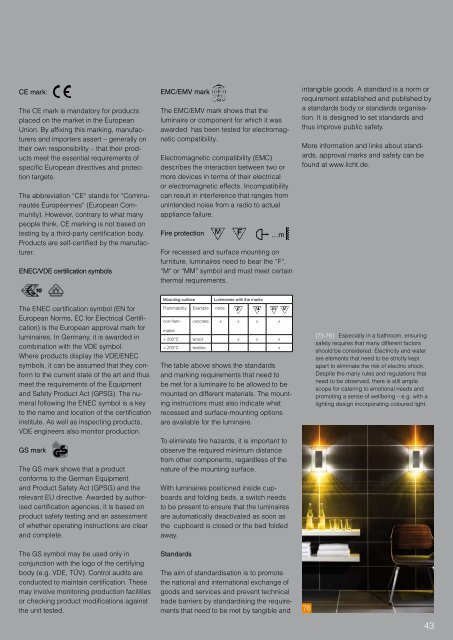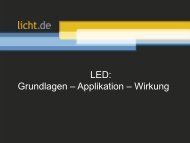licht.wissen No. 14 "Ideas for Good Home Lighting"
One of the most important things in life is having a place where we really feel at home. Booklet No. 14 gives some ideas for good lighting at home. Packed with illustrative photographs, it shows how living room, bathroom, kitchen, home office and terrace lighting can strike an inviting note. Free Download at www.licht.de/en
One of the most important things in life is having a place where we really feel at home. Booklet No. 14 gives some ideas for good lighting at home. Packed with illustrative photographs, it shows how living room, bathroom, kitchen, home office and terrace lighting can strike an inviting note. Free Download at www.licht.de/en
Create successful ePaper yourself
Turn your PDF publications into a flip-book with our unique Google optimized e-Paper software.
CE mark:<br />
The CE mark is mandatory <strong>for</strong> products<br />
placed on the market in the European<br />
Union. By affixing this marking, manufacturers<br />
and importers assert – generally on<br />
their own responsibility – that their products<br />
meet the essential requirements of<br />
specific European directives and protection<br />
targets.<br />
The abbreviation “CE“ stands <strong>for</strong> “Communautés<br />
Européennes“ (European Community).<br />
However, contrary to what many<br />
people think, CE marking is not based on<br />
testing by a third-party certification body.<br />
Products are self-certified by the manufacturer.<br />
ENEC/VDE certification symbols<br />
EMC/EMV mark<br />
The EMC/EMV mark shows that the<br />
luminaire or component <strong>for</strong> which it was<br />
awarded has been tested <strong>for</strong> electromagnetic<br />
compatibility.<br />
Electromagnetic compatibility (EMC)<br />
describes the interaction between two or<br />
more devices in terms of their electrical<br />
or electromagnetic effects. Incompatibility<br />
can result in interference that ranges from<br />
unintended noise from a radio to actual<br />
appliance failure.<br />
Fire protection<br />
For recessed and surface mounting on<br />
furniture, luminaires need to bear the “F“,<br />
“M“ or “MM” symbol and must meet certain<br />
thermal requirements.<br />
intangible goods. A standard is a norm or<br />
requirement established and published by<br />
a standards body or standards organisation.<br />
It is designed to set standards and<br />
thus improve public safety.<br />
More in<strong>for</strong>mation and links about standards,<br />
approval marks and safety can be<br />
found at www.<strong>licht</strong>.de.<br />
The ENEC certification symbol (EN <strong>for</strong><br />
European <strong>No</strong>rms, EC <strong>for</strong> Electrical Certification)<br />
is the European approval mark <strong>for</strong><br />
luminaires. In Germany, it is awarded in<br />
combination with the VDE symbol.<br />
Where products display the VDE/ENEC<br />
symbols, it can be assumed that they con<strong>for</strong>m<br />
to the current state of the art and thus<br />
meet the requirements of the Equipment<br />
and Safety Product Act (GPSG). The numeral<br />
following the ENEC symbol is a key<br />
to the name and location of the certification<br />
institute. As well as inspecting products,<br />
VDE engineers also monitor production.<br />
GS mark<br />
The GS mark shows that a product<br />
con<strong>for</strong>ms to the German Equipment<br />
and Product Safety Act (GPSG) and the<br />
relevant EU directive. Awarded by authorised<br />
certification agencies, it is based on<br />
product safety testing and an assessment<br />
of whether operating instructions are clear<br />
and complete.<br />
Mounting surface Luminaires with the marks<br />
Flammability Example none<br />
non-flammable<br />
concrete x x x x<br />
> 200°C wood x x x<br />
< 200°C textiles x<br />
The table above shows the standards<br />
and marking requirements that need to<br />
be met <strong>for</strong> a luminaire to be allowed to be<br />
mounted on different materials. The mounting<br />
instructions must also indicate what<br />
recessed and surface-mounting options<br />
are available <strong>for</strong> the luminaire.<br />
To eliminate fire hazards, it is important to<br />
observe the required minimum distance<br />
from other components, regardless of the<br />
nature of the mounting surface.<br />
With luminaires positioned inside cupboards<br />
and folding beds, a switch needs<br />
to be present to ensure that the luminaires<br />
are automatically deactivated as soon as<br />
the cupboard is closed or the bed folded<br />
away.<br />
[75-76] Especially in a bathroom, ensuring<br />
safety requires that many different factors<br />
should be considered. Electricity and water<br />
are elements that need to be strictly kept<br />
apart to eliminate the risk of electric shock.<br />
Despite the many rules and regulations that<br />
need to be observed, there is still ample<br />
scope <strong>for</strong> catering to emotional needs and<br />
promoting a sense of wellbeing – e.g. with a<br />
lighting design incorporating coloured light.<br />
The GS symbol may be used only in<br />
conjunction with the logo of the certifying<br />
body (e.g. VDE, TÜV). Control audits are<br />
conducted to maintain certification. These<br />
may involve monitoring production facilities<br />
or checking product modifications against<br />
the unit tested.<br />
Standards<br />
The aim of standardisation is to promote<br />
the national and international exchange of<br />
goods and services and prevent technical<br />
trade barriers by standardising the requirements<br />
that need to be met by tangible and 76<br />
43

















